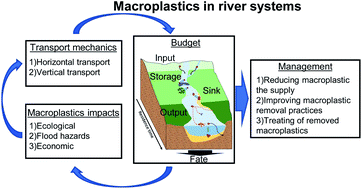Macroplastics in rivers: present knowledge, issues and challenges
Abstract
Macroplastics are the primary contributor to riverine plastic pollution by mass, posing a wide range of serious threats for riverine systems, from adversely affecting various life forms within the riverine system, to potentially increasing flood risk, and generally resulting in adverse effects on any livelihoods. Compared to other river-related research disciplines, research into riverine macroplastics and their effects has not yet featured prominently. Various quantification methods are presently used to assess the presence of macroplastics at different locations within river systems; however, overcoming limitations and unifying methods remain an essential need. Macroplastic dynamics in rivers are subject to various factors, including both material and river characteristics. We review the diverse factors that potentially influence macroplastic dynamics in rivers, and highlight our knowledge limits. We advocate for future research that enables synergies between improved field quantification techniques, use of global protocols and data sharing, and laboratory experiments. This is needed to obtain a riverine macroplastic budget model, required for the implementation of targeted management practices. Finally, a multilayer potential management strategy is presented: (i) reducing the macroplastic supply into rivers; (ii) removing effectively and safely macroplastics from within rivers; and (iii) treating macroplastics once removed from the riverine system.

- This article is part of the themed collections: Environmental Science: Processes & Impacts: Recent Review Articles, World Earth Day, SDG14: Life Below Water – Marine Litter (Plastics and Pollution) and Best Papers 2021 - Environmental Science: Processes & Impacts


 Please wait while we load your content...
Please wait while we load your content...